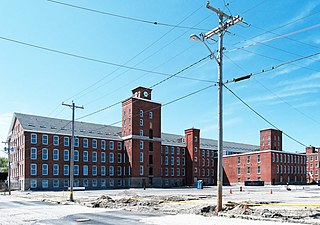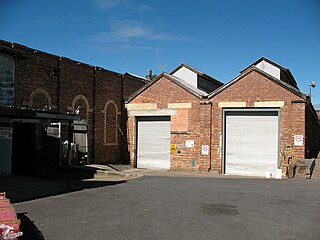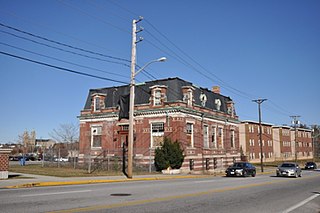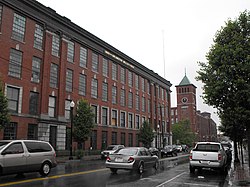
Wamsutta Mills is a former textile manufacturing company and current brand for bedding and other household products. Founded by Thomas Bennett, Jr. on the banks of the Acushnet River in New Bedford, Massachusetts in 1846 and opened in 1848, Wamsutta Mills was named after Wamsutta, the son of a Native American chief who negotiated an early alliance with the English settlers of the Plymouth Colony. It was the first of many textile mills in New Bedford, and gradually led to cotton textile manufacturing overtaking whaling as the town's principal industry by the 1870s.

The Amoskeag Manufacturing Company was a textile manufacturer which founded Manchester, New Hampshire, United States. From modest beginnings it grew throughout the 19th century into the largest cotton textile plant in the world. At its peak, Amoskeag had 17,000 employees and around 30 buildings.

The Montgomery Worsted Mills, known today as Montgomery Mills, is along the Wallkill River at the end of Factory Street in the Orange County village of Montgomery, New York. It was one of the earliest efforts to harness the river for industrial purposes.

The Philmont Worsted Company Mill is an historic mill building at 685 Social Street in Woonsocket, Rhode Island. The large three-story brick building was erected in 1919 by Joseph and Theofile Guerin, Belgian investors brought to Woonsocket by the promotional activities of Mayor Aram Pothier. Unusually for the Guerins, the mill used the "English system", instead of the French system of their other operations, for the production of worsted wool yarns. The Philmont Company was shuttered by the Great Depression in 1933, but the building was later used by other textile producers until 1955. The building has been converted to residences.

The Greenwich Mills is an historic mill complex at 42 Ladd Street in Warwick, Rhode Island. The complex was developed between 1918 and 1927, and includes four brick structures. The oldest is the weave shed, a single-story structure built in 1918. The office building was built in 1919–20, and is a 3- and 4-story C-shaped structure. This building was designed by Providence architect T. Clarence Herrmann. The finishing mill, built in 1923 and expanded in 1931, is the largest of the complex, and is located at the corner of Blackmore and Ladd Streets. The dye house and boiler house is a single-story structure built in sections in c. 1922 and 1947. The mills were built on a site where industrial activity had been taking place since about 1836. The mills produced worsted wool fabric until 1950, and are now used for a variety of light industrial purposes.

Mill Conversion or mill rehab is a form of adaptive reuse in which a historic mill or industrial factory building is restored or rehabilitated into another use, such as residential housing, retail shops, office, or a mix of these non-industrial elements (mixed-use).

Pilgrim Mills is an historic textile mill located at 847 Pleasant Street in Fall River, Massachusetts. The mill was built in 1911 from red brick and was the first mill in the city powered entirely by electricity, provided from the local grid. It was one of the last mill complexes built in the city. The property was listed on the National Register of Historic Places in 1983.

13 Annis Street is a historic mill worker house in Methuen, Massachusetts. Built about 1880, it is a typical small residence built for workers at the nearby Arlington Mills. It was added to the National Register of Historic Places in 1984, but has lost many of its exterior decorative details since.

The North Canal Historic District of Lawrence, Massachusetts, encompasses the historic industrial heart of the city. It is centered on the North Canal and the Great Stone Dam, which provided the waterpower for its many mill complexes. The canal was listed on the National Register of Historic Places in 1975, while the district was first listed in 1984, and then expanded slightly in 2009.

The Jules Desurmont Worsted Company Mill is a historic mill at 84 Fairmount Street in Woonsocket, Rhode Island. The mill complex consists of three brick buildings, erected 1907-10 by Jules Desurmont, the owner of a textile firm in Tourcoing, a city in northern France, who had been drawn to Woonsocket by the promotional activities of Aram Pothier. The mill produced French worsted wool yarn until 1952, and was used for many years thereafter by smaller textile and industrial concerns.

The Winooski Falls Mill District is located along the Winooski River in the cities of Winooski and Burlington, Vermont, in the United States of America. It encompasses a major industrial area that developed around two sets of falls on the river in the 19th century.

The Wood Worsted Mill is located at South Union St. and Merrimack Street, on the south bank of the Merrimack River, in Lawrence, Massachusetts. The mill building was constructed between 1906 and 1909 for the American Woolen Company, and was dubbed by some locals as the "eighth wonder of the world" due to its size. It is a six-story brick building that is 1,300 feet (400 m) long and 125 feet (38 m) high, and encompasses some 17 miles (27 km) of aisles. Its purpose when built was to perform the complete textile manufacturing cycle of worsted woolens, from raw material to finished fabric, under a single roof.

The Hilgen and Wittenberg Woolen Mill is a former textile factory in Cedarburg, Wisconsin. Built in 1864, the mill was one of many wool- and flax-processing factories that opened during the American Civil War, due to a shortage of cotton textiles formerly supplied by southern states. The mill produced yarns, blankets, and flannels, and was the largest woolen mill west of Philadelphia in the 19th century. The mill closed in 1968 and has since become a commercial complex called the "Cedar Creek Settlement," containing restaurants and stores.

The Hoyt Shoe Factory is a historic factory complex at 470 Silver Street and 170 Lincoln Street in Manchester, New Hampshire. It consists of two once-identical four-story brick factory buildings which face each other across Silver Street. Built in the 1890s, they housed the city's largest shoe manufacturer, an industry that gained in significance as its textile industry declined. The complex was listed on the National Register of Historic Places in 1985.

The Cocheco Mills comprise a historic mill complex in the heart of Dover, New Hampshire. The mills occupy a bend in the Cochecho River that has been site of cotton textile manufacturing since at least 1823, when the Dover Manufacturing Company supplanted earlier sawmills and gristmills. The present mill buildings were built between the 1880s and the early 20th century, and were listed on the National Register of Historic Places in 2014.

Queensland Woollen Manufacturing Company mill is a heritage-listed mill at 42 & 42B The Terrace, North Ipswich, City of Ipswich, Queensland, Australia. It is also known as Australian Fabric Manufacturers Ltd and Boral Hancock Plywood. It was added to the Queensland Heritage Register on 19 September 2008.
Pranker Mills, also known as the Iroquois Mills, is a former American textile mill located in Saugus, Massachusetts that was in operation from 1822 to 1915.

The Lafayette Worsted Company Administrative Headquarters Historic District encompasses the two surviving buildings of a once-extensive textile mill complex in Woonsocket, Rhode Island. Located near the Woonsocket Middle School on Hamlet Avenue are a former guest house, built about 1920, and the mill's 1923 administration building, an elaborate Second Empire brick building designed by Woonsocket architect Walter F. Fontaine. The Lafayette Worsted Mill, established in 1900, was one of three major local mills engaged in the French style of worsted wool production. Most of its buildings were demolished in 2008.

The Jenckes Spinning Company is a historic textile factory complex in Pawtucket, Rhode Island. Located on Conant and Weeden Streets, the complex was developed between 1883 and 1919, and was home to the city's largest employer in the 1910s, producing cotton fabric and fabric for use in automotive tires until 1933. The factory complex was listed on the National Register of Historic Places in 2018.
The Andrews Mill Company Plant is a historic industrial complex at 761 Great Road in North Smithfield, Rhode Island. Built beginning in 1918, it was home to a maker of French worsted wool textiles, part of a major industrial development push in northern Rhode Island at the time. The complex was listed on the National Register of Historic Places in 2018.






















